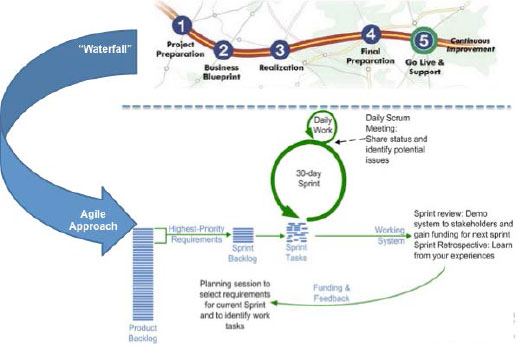Agile is the proven project management methodology that encourages the following key concepts:
-
Frequent inspection and adaptation
-
A leadership philosophy that encourages team work, self-organization, and accountability
-
A set of engineering best practices that allow for rapid delivery of high-quality projects
-
A business approach that aligns development with customer needs and company goals
Some of the foundations of agile include the following:
-
Empiricism – Ability to perform, stop, reflect, improve, and continue in a step-by-step process in efforts to increase productivity
-
Prioritization – Deliver work based on value to the business
-
Self-Organization – The team knows best how to deliver the work based on the resources and constraints
-
Time-Boxing – The team is required to complete the assigned tasks within the defined timelines.
-
Collaboration – The team commits to delivering the final products within the given timelines, which will encourage cross-team collaboration and ingenuity in completing the tasks.
Key aspects of the agile project include the following:
-
The Overall Team – Team, Scrum Master, product owner
-
Product Backlog – the ongoing, prioritized list of “to do” tasks and features that are defined by business customers
-
Sprint Planning and Backlog – planning session at the beginning of a sprint to determine the items that the team agrees to take on and deliver as the output of a sprint
-
Stories/Story Board – collection of collective elements, functions, or “features” that are to be delivered within a sprint
-
Daily Standup – daily discussion on what was accomplished, what remains to be done, and obstacles
-
Sprint Burndown Chart – artifact showing progress and work remaining in a sprint
-
Sprint Demonstration – demonstration conducted at the end of the sprint to show product(s) delivered
-
Retrospective – team discussion following the sprint to identify successes and improvement opportunities

Waterfall and Agile Project Approaches
Waterfall project management entails mapping out a project into distinct, sequential phases, with each new phase beginning only when the prior phase has been completed. The waterfall system is the most traditional method for managing a project, with team members working in a linear fashion towards a set end goal. Each participant has a clearly defined role and none of the phases or goals are expected to change.
Waterfall project management works best for projects with long, detailed plans that require one phase to be done before another can start. These projects require a single timeline and changes are often discouraged and costly. This is in contrast to agile project management, which involves shorter project cycles, constant testing and adaptation, and simultaneous overlapping work by multiple teams or contributors.
The typical stages when using waterfall project management:
-
Requirements: This is the stage in which the manager analyzes and gathers all the requirements and documentation for the project.
-
System design: During this phase, the manager designs the workflow model for the project.
-
Implementation: The system is put into practice in this phase; this is the stage where things get built.
-
Testing: During this phase, each element is tested to ensure they work as expected and fulfill the necessary requirements.
-
Deployment (in the case of a service) or delivery (in the case of a product): The service or product is officially launched in this phase.
-
Maintenance: In this final, ongoing stage, the team performs upkeep and maintenance on the resulting product or service.
The pros and cons of waterfall project management
The downside to waterfall project management is since each step is preplanned and detailed out in a linear sequence, the strategy is relatively inflexible, so any change in stakeholder priorities or needs will disrupt the order and require a revision—or, possibly, an entirely new blueprint. This is why the model is less effective for many knowledge-based projects, such as computer programming. What waterfall project management lacks in flexibility, though, it makes up for in replication possibilities: waterfall workflows can be easily copied for future, similar tasks.
Waterfall versus Agile
There are some key differences between a traditional waterfall project and an agile project and these include the following:
Waterfall
-
Detailed, long-term project plans with single timeline
-
Definitive and rigid project management and team roles
-
Changes in deliverables are discouraged and costly
-
Fully completed product delivered at the end of the timeline
-
Contract-based approach to scope and requirements
-
Customer is typically involved only at the beginning and end of a project
-
Linear-phased approach creates dependencies
Agile
-
Shorter planning based on iterations and multiple deliveries
-
Flexible, cross-functional team composition
-
Changes in deliverables are expected and less impactful
-
Product delivered in functional stages
-
Collaborative and interactive approach to requirements
-
Customer is involved throughout the sprint
-
Concurrent approach seeks to reduce dependencies
